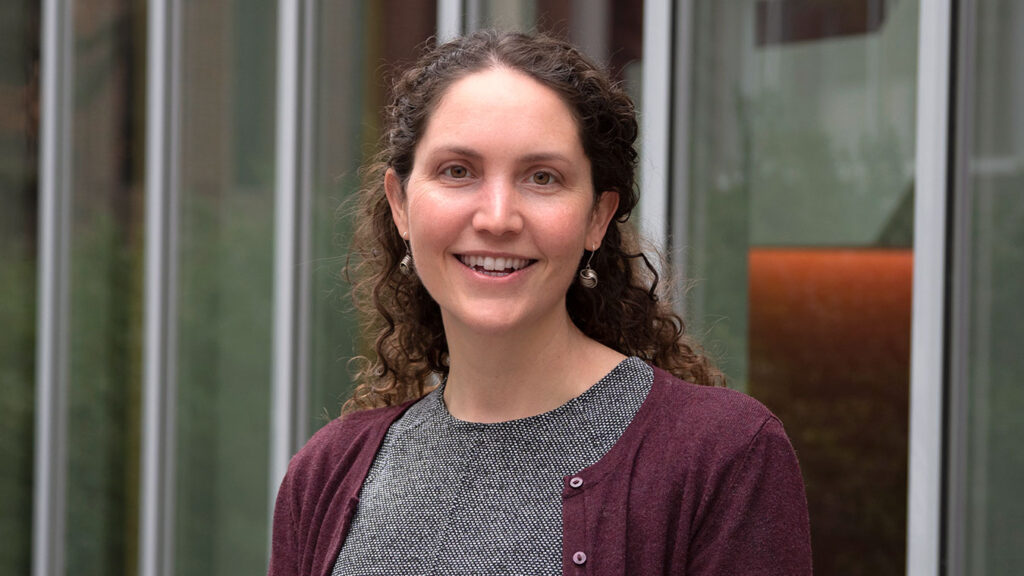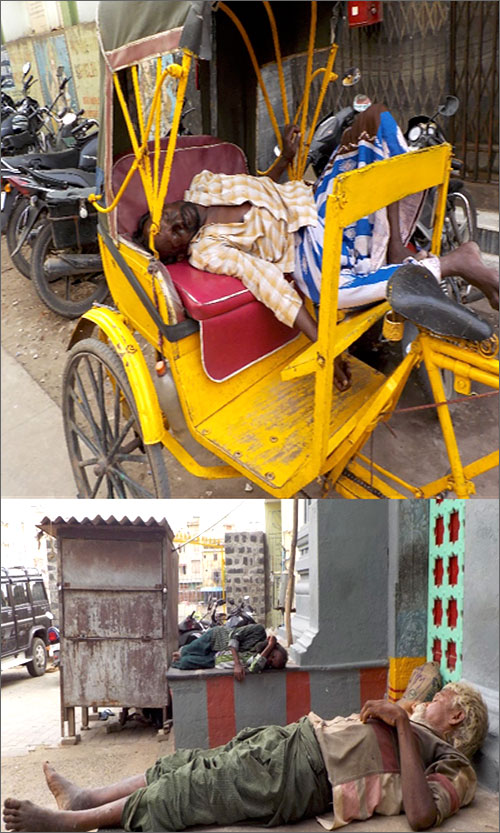
Over 500 U.S. Hospitals Have Stopped Delivering Babies Since 2010
A Crisis in Maternal Care is Unfolding—and it’s Hitting Rural and Urban Communities Alike
Population Health
News

Among the international scientists working to awaken greater attention to sleep in government policymaking circles, LDI Senior Fellow and University of Pennsylvania faculty member Heather Schofield, PhD, was featured in the recent special edition of Science magazine focused on sleep research.
Co-authoring one of the two lead articles in the influential Science Policy Forum that opened a 37-page special sleep report, Schofield and her research team reviewed the findings and policy implications of their randomized control trial and survey in Chennai, India. The article was titled “Informing Sleep Policy Through Field Experiences: Evidence is Particularly Needed from Poorer Communities.”
Science is one of the world’s top academic journals, with a weekly print readership of 400,000 and a website that logs more than three million visits a month.
The Science piece was based in part on the team’s original sleep study paper published in The Quarterly Journal of Economics in April 2021, titled The Economic Consequences of Increasing Sleep Among the Urban Poor. That work was funded by 14 granting organizations, including the Leonard Davis Institute of Health Economics (LDI) and the Government of Tamil Nadu, the Indian state in which Chennai is located.
Schofield, who joined Penn in 2015, is an Assistant Professor at both the Perelman School of Medicine and The Wharton School. She is also the Co-Founder and Co-Director of the Behavioral Development Lab (BDL) in Chennai. Her co-authors in the sleep study were Frank Schilbach, PhD, of MIT; Gautam Rao, PhD, of Harvard; Pedro Bessone, PhD, a recent MIT graduate; and Mattie Toma, a Harvard PhD student.
“This all started some years ago when I was working on another research project in Chennai,” said Schofield. “I was walking from my hotel to the research office one morning and I passed this family sleeping on the pavement on the side of a six-lane highway with trucks rumbling by in one direction and cows wandering through in the other. There were honking horns and it was really hot and mosquitoes were everywhere. I wondered, ‘How can they sleep in this?’ That got me thinking about the difference in sleep environments and how that variation might play out in terms of economic implications.”
“Not many people think about the economics of sleep,” Schofield continued. “That surprises me because economics is about making cost and benefit tradeoffs, which is what happens in personal and policy decisions about how much — or what kind of — sleep we get.”
Insufficient sleep is widely recognized in world health circles to be endemic in minority and low-socioeconomic populations around the world. It plays a significant role in the higher rates of poor health common throughout those same populations.

A companion article in the Science special section characterizes sleep deprivation as “a historically neglected aspect of racial inequity.” It quotes Marishka Brown, PhD, director of the National Center on Sleep Disorder Research at the National Heart, Lung, and Blood Institute. “Sleep deficiency is literally undermining the fabric of society, particularly in minority and low-socioeconomic populations, because they bear the disproportionate burden of the associated (health) risk. Sleep is a modifiable source of inequity.”
The Economic Consequences of Increasing Sleep Among the Urban Poor study focused on a population of low-income laborers in Chennai. It analyzed how sleep deficiency directly converts to harmful consequences, and tested interventions that might mitigate them. Results of the study included informative negative findings and a surprisingly puzzling one pointing to areas in need of further research.
~ ~ ~
A survey of several thousand people that accompanied the main Schofield randomized control trial found that Chennai’s population of low-income laborers routinely experience highly disrupted sleep — with individuals on average being pulled awake in their beds more than 30 times a night by noise, insects, heat, light, densely-crowded sleeping spaces, or psychological stress.
The study was very different from the kinds of sleep studies done in special sleep labs in high-income countries like the U.S., where patients are brought in and placed on beds wired to diagnose sleep disorders.
“Sleep deprivation studies are not new, but most of them have been done in sleep labs,” explained Schofield. “But by doing that, you’re actually changing the sleep experience. You don’t capture the reality of the person’s home sleep or understand the consequences of sleeping in whatever their home environment is, particularly if they are poor. It’s important to understand these things if you’re interested in changing peoples’ sleep in a policy-relevant way. That’s the reason we advocate the naturalistic approach to studying sleep in the field.”
In Chennai, that approach analyzed sleeping states in the subjects’ own beds at home, tested interventions in those spaces to increase the length and quality of sleep, and studied the downstream effects of that on workplace productivity and efficiency.
The project signed up its subjects to both participate in its interventions and to work for hire as data entry operators. That same data entry system served as the research tool gathering precise data about each worker’s productivity and efficiency.

Participants were provided with different kinds of assistance to help increase the length of their home sleep including counseling, financial incentives, and physical items designed to reduce the environmental disruptions and discomforts in their normal sleeping space. These included eyeshades, earplugs, fans, cots, mattresses, sheets, and pillows.
The study subjects were also fitted with wristwatch-like unit that monitored their nightly sleep. Actigraphy technology has made new kinds of field sleep studies possible in recent years. The device precisely detects body movement, then processes that data through an algorithm programmed to infer sleeping or waking states.
The researchers measured how much time the subjects slept compared to the total time they spent in bed — a standard measure of sleep efficiency. One finding of the study was that the low-income adult laborers sleep only five and a half hours a night despite spending eight hours in bed — achieving a sleep efficiency of 70%. By comparison, well-off, healthy adults in high-income countries like the U.S. routinely experience sleep efficiencies of 85% to 95%.
The arm of the study that provided interventions to improve sleeping conditions in the home did succeed in increasing the duration of the subjects’ nighttime sleep by an average of 27 minutes. But that didn’t achieve what many thought it would.
Prior to the publication of the study, the Schofield team asked 119 academic experts in the sleep science and economics fields to predict the likely impact of increasing the duration of night-time sleep on the low-income workers’ job site performance. On average, those experts predicted a 7% increase in time worked and a 12% increase in work productivity.
However, the actual field study found those predictions to be off the mark. Despite increasing home sleep duration by 27 minutes, researchers found “no significant impact” on the worker’s cognition, productivity, decision making, or wellbeing. At the same time, the period of extra sleep reduced their time on the job.

The puzzling finding came from a second arm of the study. It provided its members with 30 minutes of afternoon nap time in “nap stations” in a quiet, mildly air-conditioned, relatively bug-free section of its offices with comfortable cots and pillows. The laborers on average slept for 15 minutes during this period. Surprisingly, they subsequently demonstrated increased on-the-job cognitive ability, productivity, and other crucial measures.
“That was a really interesting and puzzling finding,” said Schofield. “When we looked at the sleep quality metrics, the naps were distinctly higher than the nighttime sleep. This might be because the sleeping environment (in the research offices) was more comfortable, or it could be that the circadian rhythm is such that there are particular times of the time when sleep is more or less valuable.”
One insight from the work is that sleep deficiencies in low-income communities in developing countries, as well as industrialized nations, may be more severe than previously understood — a fact that could have substantial health, labor, and policy implications. Another is that government policymakers, in general, may not recognize the full degree to which sleep is a crucial social determinant of health.
“It’s a complicated problem,” said Schofield, “because it’s both an individual and collective problem that has a lot of downstream implications that I don’t think are fully appreciated by everyone involved.”
~ ~ ~
Schofield’s connections to India date to her time as a Pittsburgh teenager when she took a tourist trip to the country. As a student in the Harvard School of Public Health’s Department of Global Health and Population in 2006, she visited India again to do her first research there. As a Harvard Business Economics PhD candidate, she returned to work on her paper “The Economic Costs of Low Caloric Intake: Evidence from India.”
“I just kind of got to know the place,” said Schofield. “India is a really big, diverse, complicated country that has a lot of interesting questions to look into with an infrastructure that makes the kind of research we do possible. There are a lot of well-educated people there interested in the same kinds of research; it was a real pleasure to work with them, and we wanted to create longer-term working relationships.”
Ultimately, she and two other young Harvard colleagues — Frank Schilbach, PhD and Gautam Rao, PhD — opened a small research lab in Chennai under the aegis of India’s Institute for Financial Management and Research (IFMR) to support their growing cluster of research projects. IFMR is a non-profit institute within India’s Krea University supporting macro and microeconomics, financial and management research, and education focused on issues of equity in all those areas.
Called the Behavioral Development Lab (BDL), the 10-year-old operation began with five staff members and, before the pandemic, expanded to as many as 65 staffers working on various research projects. Today, it is staffed with 43 personnel including principal investigators, PhD candidates, research associates, field managers, and faculty affiliates.
The twelve most recent BDL research projects have been funded by 33 major academic and international philanthropic organizations, including the Global Engagement Fund and LDI at the University of Pennsylvania, and similar funding entities at Harvard, MIT, Columbia, Princeton, and the University of California at Berkeley.
Some of these BDL projects are:
• Impact of the COVID-19 Lockdown on the Indian Village Economy
• Mitigating the Economic and Mental Health Impacts of COVID-19 in India
• Developing the Ability to Sustain Attention
• The Economic Consequences of Depression
• The Barriers to Demand for Mental Health Services
Now a widely recognized as an authority on an array of population health-related economic and behavioral policy issues in India, Schofield is routinely quoted in publications like the Economic Times, India Business Standard, India West, Pakistan Today, The Indian Express, The World Bank Blog, and BBC News India.
During the pandemic, as strict travel restrictions and safety measures slowed research operations, BDL pivoted to broad phone surveys gathering data and insights to inform the Indian government’s efforts to contain the spread of COVID-19 and address its unique challenges. For instance, India has a vast population of workers who regularly commute long distances back and forth between the city and their villages. Huge numbers of these workers were stranded in the cities after the government’s rapid implementation of strict emergency restrictions on regional travel and transportation systems.
The issue was that the stranded laborers had no money, food support, or other resources because all their state support services were tied to their households in the distant villages. BDL, which has wide contracts throughout this population of laborers, is using phone surveys to inform policymakers about the workers’ major barriers and the kinds of services they were and were not able to access and needed in their isolation.
BDL is currently working to return to full research operations. Aside from Chennai, which it has made famous in the world of sleep science, the lab has research projects underway in other cities across India.
Schofield’s latest personal research project is a study of the economic and health consequences of loneliness throughout low-income migrant populations in the city of Bangalore.


A Crisis in Maternal Care is Unfolding—and it’s Hitting Rural and Urban Communities Alike

Stable Payments Improved Margins But Not Liquidity, New LDI Analysis Finds

LDI Senior Fellow Cited for “Significant Contributions” in Research

Outdated Laws Target Black and Queer Lives in Over 30 States, Fueling a Deadly Disease

Selected for Current and Future Research in the Science of Amputee Care

Research Memo: Delivered to House Speaker Mike Johnson and Majority Leader John Thune